Government institutions are known for having their set systems and mechanisms. Each agency has their own protocols and ways of arranging day-to-day operations. These mechanisms are in place to ensure that the job is getting done. Introducing Microsoft Teams can help ensure that the job is getting done efficiently.
In this article, we will discuss why government institutions need Microsoft Teams and how they can benefit from it. So, without further ado, let’s get started.
Why do state governments even need Microsoft Teams?
The idea behind the whole state apparatus is that it has systems, mechanisms, and approaches in place, so that its institutions run like clockwork. So, why bring in a third-party tool? Microsoft Teams is not coming to replace the systems and mechanisms in place. Instead, it will help them work properly. Teams is a platform that government employees can use to enact the existing systems and mechanisms.
By integrating Microsoft Teams templates into their work, government agencies will be able to accomplish a lot more in a shorter period. The platform supports remote workers by helping them seamlessly connect and collaborate with fellow colleagues from the office. Through its integration with other apps, Teams can help government officials better organize their tasks, work on projects and initiatives, manage citizens’ requests, appeals, etc. Plus, Microsoft Teams is extremely secure. Capabilities built into Teams enable you to block sensitive information from being shared in chat messages with people who shouldn’t see it.
Microsoft Teams features that suit the work of government institutions
To help you better understand how exactly Microsoft Teams contributes to the work of government institutions, we have highlighted a couple of key features of this platform that particularly suit the needs of government institutions.
Communication
Just like in any kind of work environment, communication channels are extremely important in government institutions. Clear and fast inter- and intradepartmental communication is crucial in these institutions. Especially in the times of COVID-19, when remote work has become the norm in many countries, the need for an all-in-one communication platform is a pressing need. Microsoft Teams comes to solve this problem with private and group chats for instant messaging, channel conversations for keeping entire teams up to date with current events, online meetings, and audio calls. Whether it is a quick question that is answered within seconds or a long strategy meeting, Microsoft Teams is there to enable the communication.

Document management
Working with tons of documentation is an integral part of government officials’ job. Microsoft Teams allows secure storing, accessing, sharing, and collaborating on documents in real time, thus facilitating document management and improving collaboration.
Microsoft Teams is committed to ensuring safety and security. It is of utmost importance in any industry but is particularly critical for government organizations.
Governments deal with highly sensitive data daily and it’s important that the tools and platforms used to store, access, and modify these data are safe. Microsoft Teams is built on the hyper-scale and enterprise-grade cloud of Microsoft 365. The platform employs team-wide and organization-wide two-factor authentication, single sign-on through Active Directory, and encryption of data in transit and at rest. Plus, files shared in Microsoft Teams are stored in SharePoint, and are backed by SharePoint encryption.
Microsoft Teams prioritizes security and constantly updates its policies to ensure that your data is safe. You can learn more about the Safety and Security policies of Microsoft 365 here and more on the security and compliance in Microsoft Teams here.

Planning and task management
In terms of operations (both yearly and day-to-day), government institutions are no different from any other organization in any given field. Governments strategize and plan before proceeding with implementation. Microsoft Teams is great for planning and monitoring both bigger strategic tasks and activities for the year, and also smaller monthly or weekly tasks. You can connect it with online calendars, native task management tools such as Microsoft Planner or third-party apps such as Asana, Trello, Jira and others.
Learn more about Planner templates in Microsoft Teams.
Approval process
One of the biggest “to-dos” in government institutions is approvals. There are constantly dozens and even hundreds of documents and requests that officials need to review and approve. Approval app in Microsoft Teams facilitates and accelerates the process. You can learn more about it here.

Note taking
Government employees can highly benefit from Microsoft Teams and OneNote integration. It enables them to collaborate on ideas and share them with fellow colleagues.
You can use OneNote for virtually anything that requires written content. Use OneNote to capture and share notes before, during, and after a Teams meeting.

It can also be a repository for guidelines, a place to write down brainstorming ideas and suggestions, and keep information such as useful resources, best practices, schedules, personal notes, etc.
The benefits of using Microsoft Teams in state governments
The biggest benefit of Microsoft Teams is that it’s all-in-one. You don’t need to use one platform for chatting, one for calls and a completely different one for document storage. Microsoft Teams can be that one uniform tool that is used across all agencies and all departments.
Microsoft Teams is particularly convenient for governments that still work remotely or opted for a hybrid working model. It enables constant communication and access to relevant files, calendars, tasks, and meeting notes regardless of location, and ensures security.
Plus, Microsoft Teams has many third-party integration opportunities. So, if you can’t find a default feature that is needed for your institution, you can certainly find and connect one that is tailored to your needs.
Microsoft Teams templates for government institutions
To make sure government employees are aligned with the colleagues of the same function, they require a separate collaboration workspace. The best practice here is to create individual teams for each government agency and department. At the same time, you may want these teams to have a similar organization and follow the same structure and naming rules. Here’s where Microsoft Teams Collaboration templates come in.
Templates are pre-built definitions of a team structure that allow to create teams faster with already established settings, pre-installed channels, files, tabs with apps and other content.
Let’s see how Collaboration templates by SalesTim can help government agencies via an example.
Suppose you work for the Ministry of Education (or a similar entity in your country) and within the ministry there are different departments that have a similar workflow. So, you want to introduce Teams to organize the work of these departments.
You can create one team, add private and standard channels, and upload all the required content that can be useful for employees of all the departments within the ministry. Then, using Collaboration templates, you replicate that structure and automatically create ready-to-go teams for each division/department under your ministry. You’ll make an effort once to create a template, and then replicate it and tailor to the needs of each= department.
Now, let’s see what an MS team looks like and what features are available to you. Continuing with our Ministry of Education example, say you want to have a team dedicated to the General Education Department. For that you create a team on which you’ll base the template and call it the General Education Department – Template.
Channels
Within the team, add standard and private channels that represent areas on which your departments and offices work on, such as:
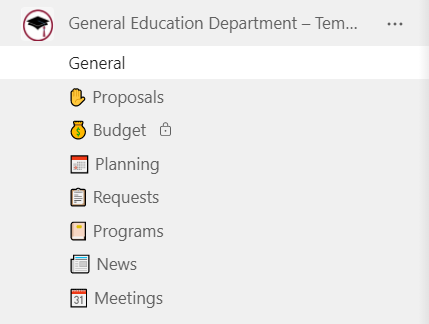
- Planning
- Programs
- Meetings
- Budget
- News
- Proposals
- Requests, etc.
Having such distinct channels for each subject will allow your teams to have focused discussions and navigate the content much more easily.
Within the channels, you will have tabs that you can also customize. Here are some examples of tabs that might come in handy for government institutions.
Files and tabs
Files tab in each channel is where you can upload all the files required for your employees. This is the place where your employees can store and manage documentation. For example, press releases, reports, acts, legal documents, codes of conduct, etc.
Once you build the original team with all the necessary standard and private channels, tabs with OneNote, Forms, and Planner with some standard tasks, you can use SalesTim app to create a Collaboration template.
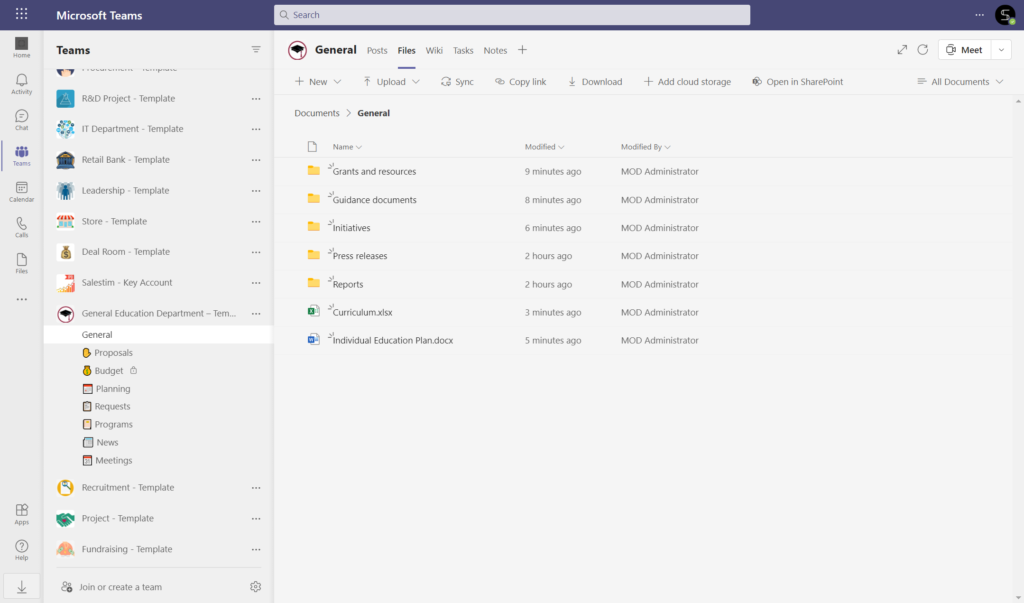
Click on SalesTim tab, head over to Catalog and choose +New template.
During the template creation, you can configure governance policies. Using this template, the users can create new teams which will have the same structure, sparing the hassle of creating brand new teams from scratch for each department.
Governance policies
Governance policies established at the template level help keep coherence among your teams.
Naming convention
You can establish naming rules at the template level so that teams created via the template are named in a specified way. For example, you may want to set up dynamic content for your naming convention, such as department name.
Department – Ministry of Education
This way if an employee from the Department of Development Planning creates a team from the template, it will be automatically called:
Department of Development Planning – Ministry of Education.
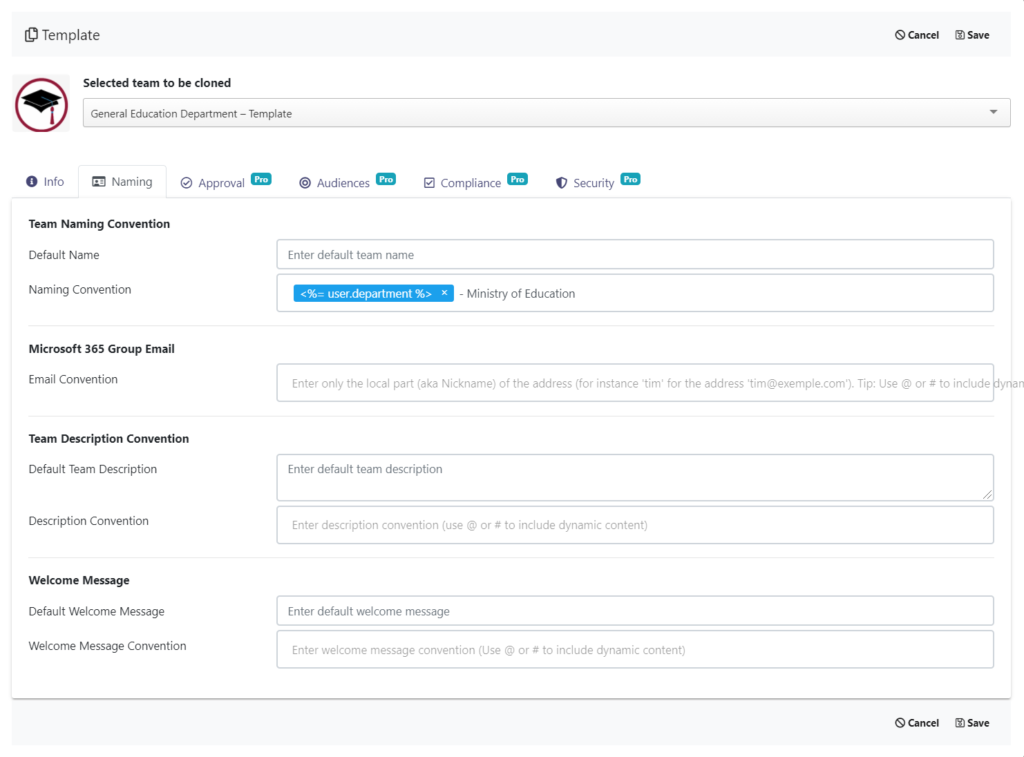
Audience targeting
You can select certain groups in your department that will be able to use the templates. The targeting is up to you. It can be based on their geographic location or position within the department (e.g. heads of subdivisions).
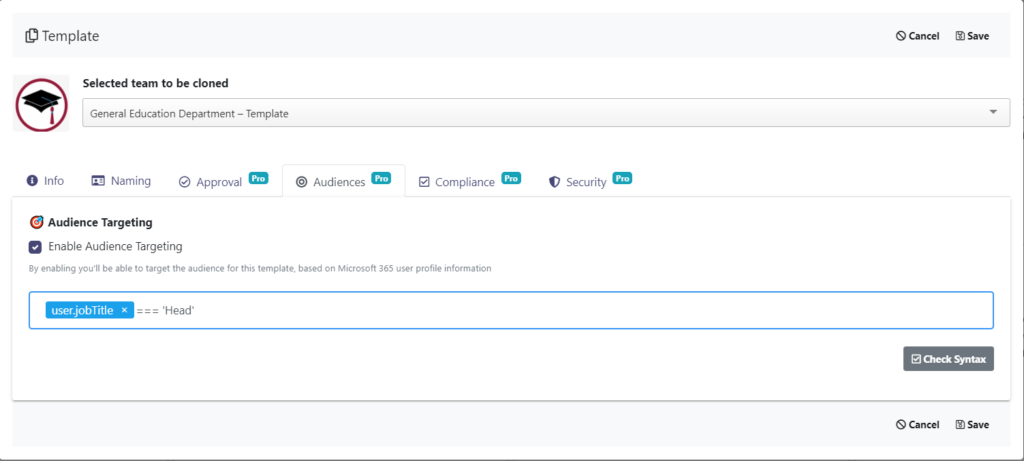
Approval workflow
This is a security mechanism which when enabled, sends you a notification when one of your users tries to create a team from your template. You can assign specific people the ability to process team creation requests.
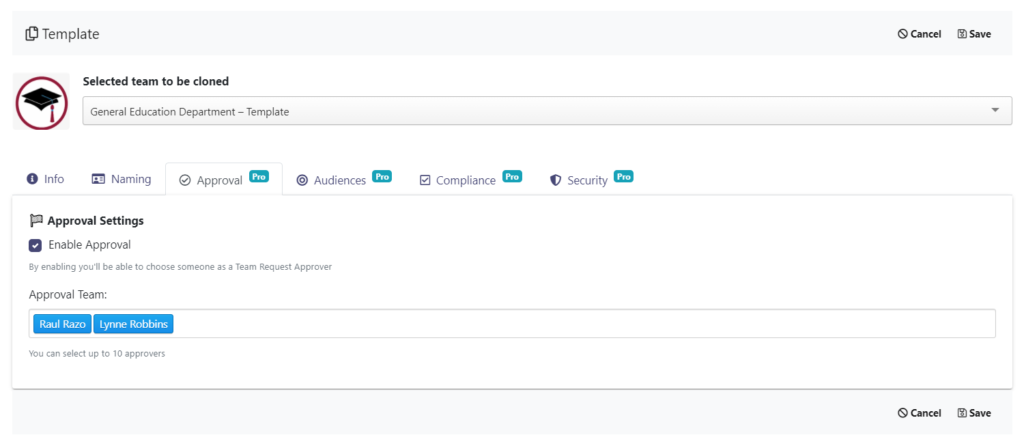
Permanent owners and members
Another notable feature that helps reduce the amount of manual work. When you create a template, you can assign specific users as Permanent owners or members. This way, when a new team is created from the template, these people will be automatically added to it. Permanent owners are also added to private channels.
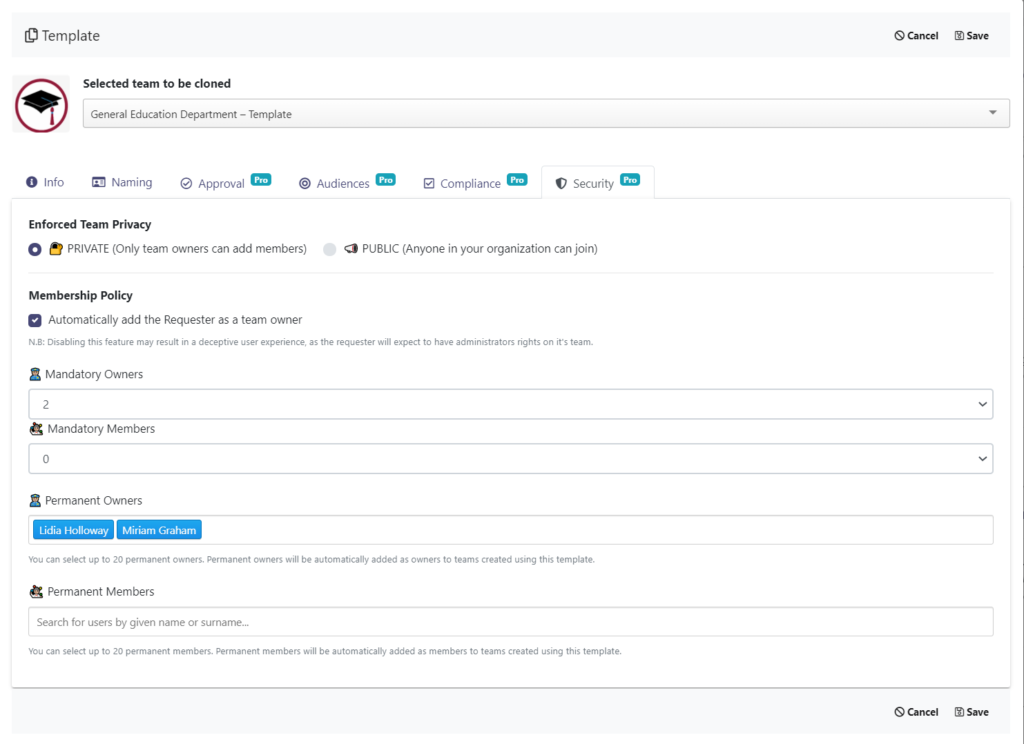
Collaboration is the key to success in any industry and in any organization be it public or private. Government agencies and institutions are no exception. Microsoft Teams templates enable uninterrupted internal communication and collaboration between team members in different government agencies and promotes cross-departmental cooperation.
Talk to our team to learn how your institution can benefit from Collaboration templates.
